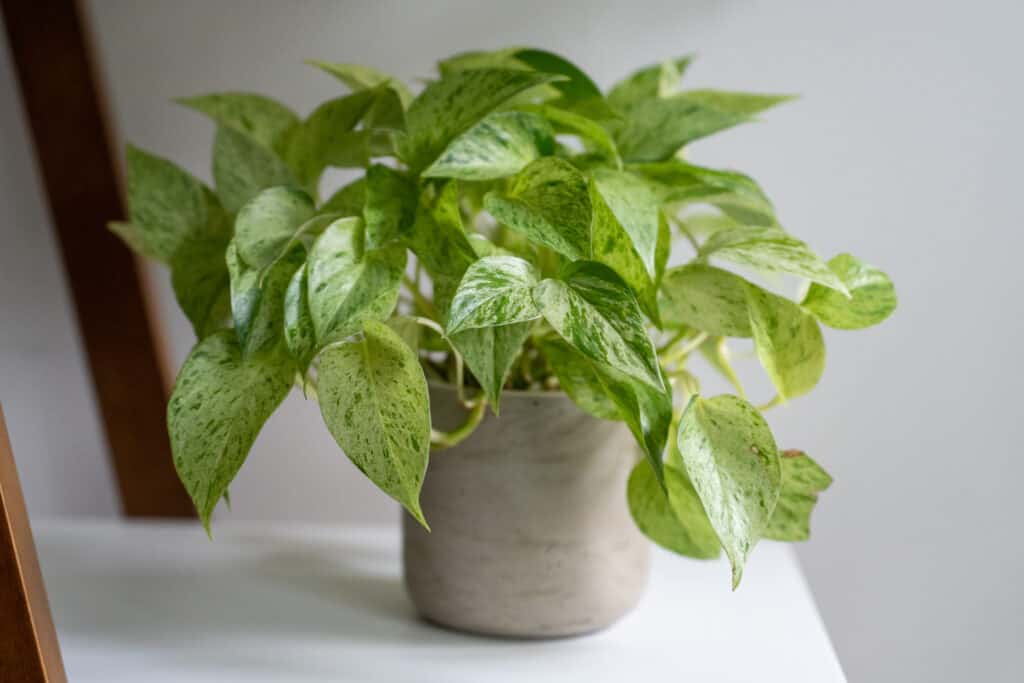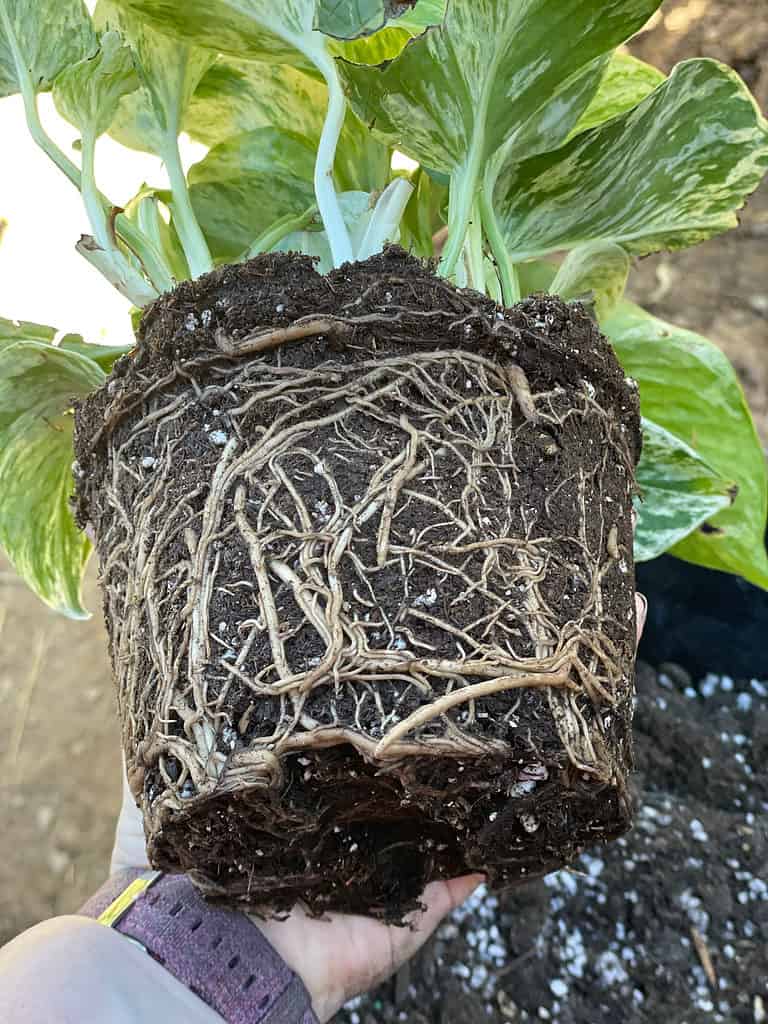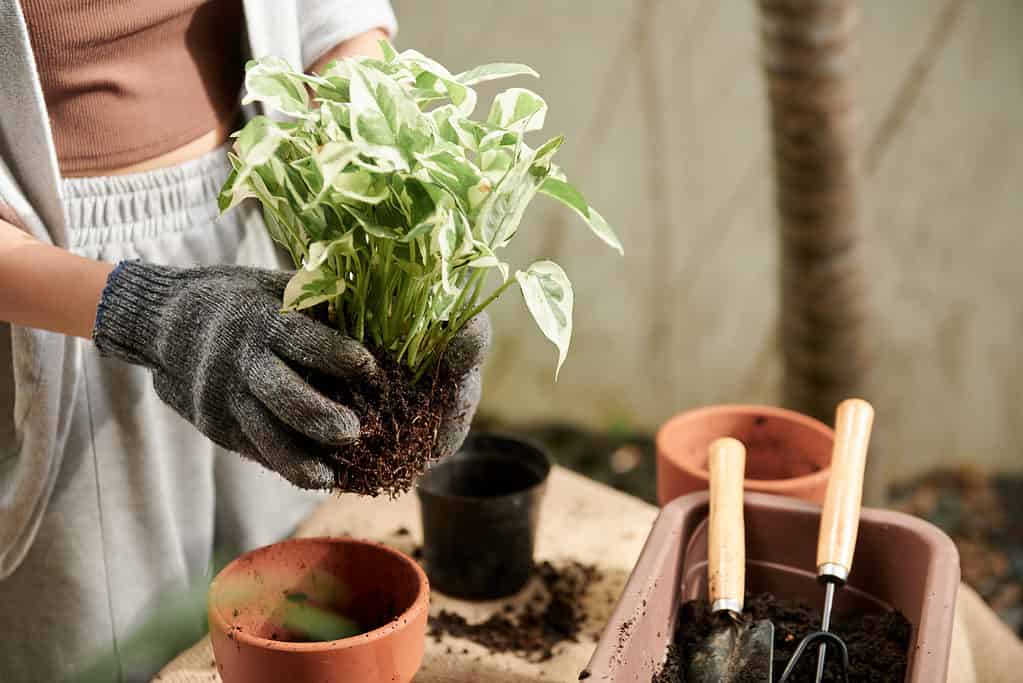If you grow pothos as a houseplant, it’s crucial to know why, when, and how to repot this lovely tropical plant. Repotting plants is essential to allowing room for the roots to grow and replenishing nutrients in the soil, which degrades over time.
In this guide, we’ll cover pothos’s growth rate, when it generally needs to be repotted, signs the plant has outgrown the pot, and how to repot pothos to help it thrive safely.
So, without further ado, let’s jump in!
Pothos: Plant Classification
A beloved houseplant for its low-maintenance growing requirements and lovely vining foliage, pothos also exists naturally where it thrives in tropical environments. Native to the Solomon Islands of the South Pacific, pothos, Epipremnum aureum, belongs to the Araceae family of plants. These plants are also known as arums or aroids.
A common characteristic of plants in the Araceae family is that their flowering structure is composed of a spathe and spadix. The spadix is a fleshy cylindrical spike of minute flowers normally partially enclosed by a protective leaf structure (the spathe). In the wild, mature pothos will sometimes produce this structure, although this tropical vine is known for “shy-flowering” as it rarely blooms and, instead, tends to reproduce through self-cloning.
As a houseplant, pothos remains in its juvenile state and never reaches the mature phase it needs to enter in order to produce a spadix and spathe. In this juvenile, or vegetative phase, pothos typically grows up to 10 feet long and, depending on the cultivar, produces leaves about 3-6 inches long.

As a houseplant, pothos remains in its juvenile state, typically growing up to 10 feet long with leaves about 3-6 inches long.
©iStock.com/Jenny Sun
Repotting Pothos: When to Repot
When growing pothos as a houseplant, knowing how often to repot this plant is crucial as pothos is quite the fast grower at 8-12 inches per month. This speed of growth only occurs with ideal growing conditions and during its growing season in spring and summer. In the fall and winter, pothos becomes dormant unless temperatures stay above 70 degrees Fahrenheit.
With this speed of growth, you’ll want to make sure that you repot pothos often enough to prevent it from becoming rootbound and to encourage its continued growth. With its rate of growth, you’ll normally want to repot this houseplant about once a year.
Signs your Pothos Has Outgrown its Pot
Ideally, you’ll repot pothos before it starts to struggle from having outgrown its pot. However, it’s still important to recognize the following signs:
- Stunted growth
- Roots growing through the pot drainage hole
- Roots pushing through the surface of the soil
- Roots circling the edges of the pot
- Soil drying rapidly after watering or pulling away from the edges of the pot
- Drooping or curling leaves
Some of these signs can occur due to other problems. If you suspect your pothos has outgrown its pot, gently take the plant out of the pot and check its roots. If your pothos houseplant has outgrown its pot, you’ll likely notice some degree of the plant being root bound. The roots may be mildly tangled, or they may be tightly interwoven and difficult to ease apart gently.

Repot pothos often enough to prevent it from becoming rootbound and to encourage its continued growth.
©Rebekah Zemansky/Shutterstock.com
Repotting Pothos: Setting Your Plant up for Success
Now, no matter when you decide to repot your pothos, you’ll want to ensure you are set up for success. This means choosing the right pot, using fresh soil, and handling your plant carefully.
Choosing the Right Pot
Choose a pot that is about 2 inches larger in diameter than the size of your pothos’ rootball. This size will allow the roots to grow without an excess of soil. Excess soil can hold onto moisture, which can lead to rot. For pothos, you can choose a variety of pots to fit your aesthetic preferences.
The most common options are plastic or terracotta pots. Terracotta containers can look stunning, but they are heavy. They may not be the best choice for placing your plant up high or in a hanging basket. Plastic pots are lighter in weight, so they can be an optimal choice for use in hanging baskets. You can also choose hanging baskets that conceal the plastic pot. Essentially, your pothos houseplant will be happy if the pot is the right size and has a drainage hole.
Use a Fresh Growing Medium
When repotting your pothos, it’s crucial to use new potting soil. This will provide your newly repotted plant with the most nutrients. The nutrients in potted soil deplete over time, so it’s important to make sure you use a fresh potting mix that supports this plant’s growing needs. Remember, without proper nutrients; your plant will suffer from problems like stunted growth, yellowing leaves, wilting, etc. Additionally, you’ll want always to make sure to use well-draining, aerated, and slightly acidic (6.0-6.5 pH) soil. For many tropical houseplants, including pothos, slightly acidic soil is ideal for accessing the most nutrients.
Repotting Pothos: Handle Your Plant with Care
Removing your houseplant from its pot and replanting it can cause stress if aren’t careful with your plant. Transplant shock can occur, which can seriously stress or kill your plant, so always ensure you’re gentle in the repotting process. Transplant shock is more likely to occur for plants grown outside in direct sunlight and exposed to wind and other elements. However, you can still cause transplant stress in your houseplants by roughly handling the plants (especially the roots), repotting into insufficient soil, and repotting a dehydrated plant.
So, it’s a good idea to thoroughly water your pothos a couple of days before repotting so that the plant isn’t dehydrated. When handling the plant, make sure to be especially gentle with the roots, which are especially susceptible to shock when moving. Once repotted, make sure to protect your plant from direct sunlight, as any plant. Still, especially plants that thrive in indirect sunlight can suffer damage from transplanting when immediately exposed to direct sunlight. Ideally, it’s best to repot pothos in the spring while the roots are in their growing phase and can fill out the space in the new pot.

When handling your pothos, make sure to be especially gentle with the roots to avoid transplant shock when being moved.
©iStock.com/DragonImages
Repotting Pothos: Step by Step
To repot successfully repot pothos, follow the steps below:
- Thoroughly water your plant a couple of days before you plan to repot.
- Prepare your new pot with your fresh potting mix, and make sure the pot is 2 inches larger in diameter than the size of the root ball.
- Gently remove your pothos from the old pot. If the plant is rootbound, gently tease apart the roots until they are no longer tangled, or for more severe cases, use a sharp knife or pruning shears to make some 1/2″ deep cuts along all sides and bottom of the root mass to prevent further spiralling of the roots around the root ball.
- Plant your pothos into the fresh soil and new pot.
- Set the plant in low-medium intensity indirect sunlight for about a week and make sure it’s adequately watered. Remember that plants are fragile after repotting, so take special care to ensure you meet all their growing requirements.
- After about a week, if you choose and if the cultivar calls for brighter lighting, you can move your pothos to a place with brighter indirect sunlight. Cultivars with lots of white variegation, like ‘Marble Queen’ and cultivars with yellow-green leaves, like ‘Neon,’ would fall under this category.
- Continue to provide the proper growing conditions for your pothos, and plan to repot again in about a year!
The photo featured at the top of this post is © Dragon Images/Shutterstock.com
Thank you for reading! Have some feedback for us? Contact the AZ Animals editorial team.







